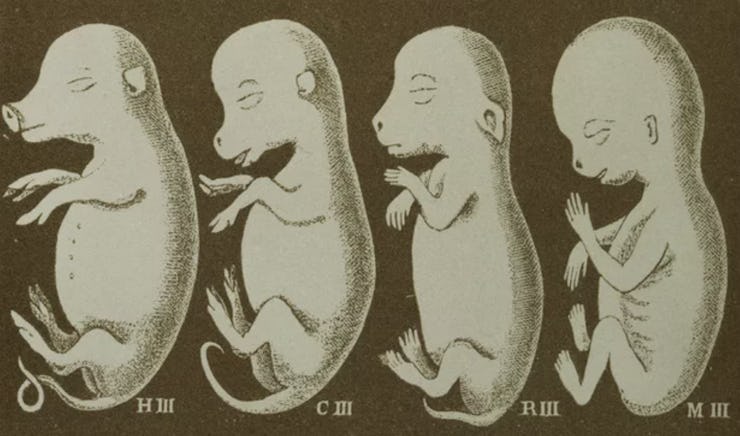Ernst Haeckel's Bizarre, Refuted "Theory of Recapitulation" Explored in New Book
What we thought embryos looked like before ultrasounds.

From the early cave paintings in Lascaux in the Southwest of France, painted with hands and hollow bone, to the ethically questionable practice of plastination, humankind has tried to preserve the likeness of animals for millennia. In doing so, we leave behind detailed labors of love and fascination, a snapshot of our scientific understanding at the time.
In an arresting journey in comparative anatomy, Stripped Bare: The Art of Animal Anatomy looks at the insides of animals and reflects back humankind’s relationship with them and ourselves, from antiquity to today. Author David Bainbridge, University Clinical Veterinary Anatomist at the University of Cambridge, unlocks new ways of seeing through his exquisite descriptions of this stunning collection of illustrations.
From Charles Darwin’s voyages, to Edweard Muybridge’s cockatoo time-lapses, Bainbridge explores the philosophical, scientific, and artistic settings that informed humanity’s ongoing pursuit to understand the curiosities of nature around us.
Below is an excerpt from Stripped Bare, published last month by Princeton University Press.
`Stripped Bare`
Ernst Haeckel (1834–1919): Development of the Embryo, Development of the Race
Ernst Haeckel, Professor of Zoology at Jena, was an unusual person—a traveler-savant, embryologist, artist, ultra-Darwinist, and self-promoter who even expounded his own pseudo-religion premised upon his ideas of development, evolution, race, and religion.
Haeckel’s scientific and artistic output was profuse, from the watercolors of his youthful wanderings around the globe to his later sharp engravings extolling the patterns and geometry present in the animal kingdom. As well as being a working scientist, he was also a hugely successful popularizer of science, his many books selling worldwide, and he traveled around Europe with his roadshow of skeletons, embryos, and diagrams. Few have so successfully used their art to impose scientific opinions on future generations.
Ernst Heinrich Philipp Haeckel (1834–1919), “The Evolution of Man: a popular exposition of the principal points of human ontogeny and phylogeny”, 1874; Development of the Face: M, Man; B, Bat; S, Sheep; C, Cat.
Haeckel’s life changed when he read Darwin’s On the Origin of Species, and there followed an uneasy scientific correspondence between the cautious, cerebral Darwin and his argumentative, bombastic protégé. Haeckel pushed the theory of natural selection further than anyone else by firmly binding it to his own main field of study, embryology. In the nineteenth century, many biologists already realized that evolution and development must be linked in some way, but it was Haeckel who claimed they were directly equivalent processes.
According to his Law of Recapitulation, every animal passes through all the stages of its evolutionary history as it develops as an embryo — thus humans would be said to go through single-celled, wormlike, fishlike, reptilelike, shrewlike, and monkey-like phases before becoming truly human. This idea may seem strange now, but it has been repeated to biology students ever since, even though it was largely refuted in the 1920s.
Ernst Heinrich Philipp Haeckel (1834–1919), “The Evolution of Man: a popular exposition of the principal points of human ontogeny and phylogeny”, 1879; Embryos of two lower and two higher vertebrates. This image is the most controversial in all of animal anatomy. To comply with his theory that animals re-enact their evolutionary history as they develop as embryos, Haeckel needed the early stages of all species’ development to look as similar as possible, and to diverge only in the later stages.
So potent was the idea that it imbued a spurious sense of “progress” into evolutionary biology that was scientifically misleading when used to claim, for example, that monkeys are more “advanced” than sharks. But when Haeckel used his theories to claim that Europeans are superior to other humans, or that Judaism is an inferior, primitive forerunner to Christianity, one can sense the seeds of Nazi racial policy being sown.
Excerpted from Stripped Bare: The Art of Animal Anatomy* by David Bainbridge. Copyright © 2018. Published by Princeton University Press
Stripped Bare: The Art of Animal Anatomy is available now.